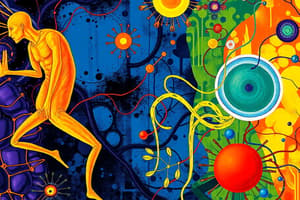Podcast
Questions and Answers
¿Cuál es la función fundamental de los seres vivos en la que se basa el movimiento?
¿Cuál es la función fundamental de los seres vivos en la que se basa el movimiento?
- Reproducción
- Crecimiento
- Supervivencia (correct)
- Adsorción
¿Qué tipo de movimiento implica el cambio de lugar de un organismo?
¿Qué tipo de movimiento implica el cambio de lugar de un organismo?
- Movimiento muscular
- Movimiento de partes del cuerpo
- Locomoción (correct)
- Movimiento celular
¿Qué mecanismo de movimiento se utiliza en los seres vivos que alteran la presión de los fluidos para moverse?
¿Qué mecanismo de movimiento se utiliza en los seres vivos que alteran la presión de los fluidos para moverse?
- Movimiento hidrostático (correct)
- Movimiento osmótico
- Movimiento ciliar
- Movimiento muscular
¿Por qué es importante el movimiento en los seres vivos?
¿Por qué es importante el movimiento en los seres vivos?
¿Cuál es el tipo de movimiento que se produce en las células durante la mitosis?
¿Cuál es el tipo de movimiento que se produce en las células durante la mitosis?
¿Qué parte del cuerpo se mueve en el movimiento de partes del cuerpo?
¿Qué parte del cuerpo se mueve en el movimiento de partes del cuerpo?
¿Qué tipo de movimiento se produce en protozoos y algunos invertebrados?
¿Qué tipo de movimiento se produce en protozoos y algunos invertebrados?
¿Por qué es importante el movimiento para la supervivencia de los seres vivos?
¿Por qué es importante el movimiento para la supervivencia de los seres vivos?
¿Qué papel juega el movimiento en la reproducción?
¿Qué papel juega el movimiento en la reproducción?
¿Cuál es el resultado del movimiento en los seres vivos?
¿Cuál es el resultado del movimiento en los seres vivos?
Flashcards are hidden until you start studying
Study Notes
Movement in Living Organisms
Movement is a fundamental function of living organisms, essential for their survival, growth, and reproduction.
Types of Movement:
- Locomotion: Movement from one place to another, such as walking, running, swimming, or flying.
- Movement of body parts: Movement of specific body parts, such as the movement of limbs, fingers, or eyes.
- Cellular movement: Movement of cells or cellular components, such as the movement of chromosomes during mitosis.
Mechanisms of Movement:
- Muscular movement: Movement generated by the contraction and relaxation of muscles, such as skeletal muscles in humans.
- Hydrostatic movement: Movement generated by the contraction and relaxation of muscles that alter the pressure of fluids, such as in worms and mollusks.
- Ciliary movement: Movement generated by the beating of cilia, such as in protozoa and some invertebrates.
Importance of Movement:
- Foraging and feeding: Movement allows organisms to search for food and nutrients.
- Predator avoidance: Movement helps organisms to escape from predators and protect themselves.
- Reproduction: Movement is essential for the reproduction process, such as the movement of gametes during fertilization.
- Environmental adaptation: Movement allows organisms to adapt to changes in their environment, such as migrating to new habitats.
Examples of Movement in Different Organisms:
- Animals: Walking, running, swimming, flying, and crawling.
- Plants: Tropisms, such as phototropism (growth towards light) and geotropism (growth towards gravity).
- Microorganisms: Flagellar movement, such as in bacteria, and amoeboid movement, such as in protozoa.
Studying That Suits You
Use AI to generate personalized quizzes and flashcards to suit your learning preferences.




